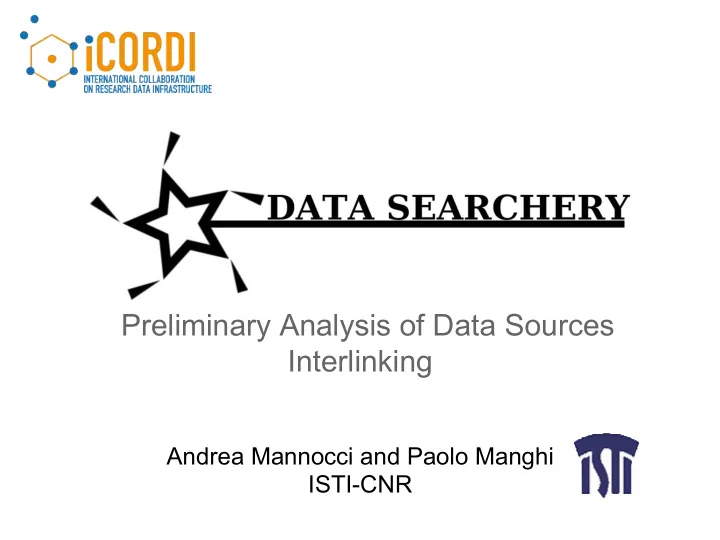

Preliminary Analysis of Data Sources Interlinking Andrea Mannocci and Paolo Manghi ISTI-CNR
Modern eScience workflow
Modern eScience workflow Lack of tools for data-publication interlinking ? Research Digital Libraries Research Data Repositories Benefits: ● Foster multidisciplinary research by looking at adherences among distinct disciplines ● Enable better review, understanding, reproduction and re-use of research activities
Scientific Communication Infrastructures Interlinking and contextualizing publications and data sets Services and tools for ● Aggregation of content (e.g. harvesting, harmonization, inference, editing) ● Provision (e.g. web portals, standard APIs) Scientific Communication Infrastructures Research Data Research Digital Repositories Libraries
Scientific Communication Infrastructures Drawbacks ● High costs for design and development ○ Ever changing requirements from case to case and over time ○ Long time-to-deployment ○ Critical maintenance procedures ● High costs of operation ○ Data curation ○ Data inference
The idea Design a tool... ● Light ● Flexible ...enabling users to surf and ( best-effort ) relate on-the-fly metadata present in two different web data sources. In such a way: ● Unneeded costs (of aggregation) during SCIs development can be cut ● Users can search for and play with metadata even if a SCI is not yet ready Not only! ● It can be used as an alternative to SCI, whenever SCIs are not affordable ● It can be integrated to existing SCIs as an additional tool for mining
Data Searchery at a glance Research Digital Research Data Libraries Repositories Data Searchery ● Data searchery just runs real-time queries on web data sources: no metadata harvesting, nor pre(post) processing takes place. ● Data Searchery combines the textual query with information extracted from selected metadata fields thanks to extraction filters. ● With Data Searchery an user can query two data sources and interlink their objects in just one browser tab .
Data Searchery at a glance
Data Searchery Main actors in play Data Source ● Export of XML-formatted metadata ● Apache Sorl web search api ● Optionally organized into collections Extraction Filter ● Keywords extraction from metadata fields ● Implementation can be ○ local ○ remote (demanded to external web services, e.g. whatizit, text tagger services, etc.)
Data Searchery Extendibility considerations Data Searchery can be easily customized by adding a few classes ○ New data sources ○ New extraction filters
Data Searchery An example 1. Select an origin data source out of the ones implemented (say Datacite.org) 2. Search for some keyword (let’s go for ”calcification foraminifer”) 3. Select a target data source (say OpenAIRE+) and check out “Author filter” 4. Choose a record and click on the magnifying glass 5. Check the right column for results!
Data Searchery Testing results ● The tool in its current version helped us in finding and confirming some linked publications and datasets within the OpenAIREplus infrastructure. ● Alas.. no epiphanies! ○ Data Searchery works better if you somehow have some prior understanding on what’s inside repositories. ○ Finding totally unexpected relationships given whatsoever queries and two random data sources is seldom.. (so far!) ● Furthermore, the recall of the approach is proportional to: ○ how rich and accurate metadata records are ○ how good filters have been implemented ○ how much cohesion there is between two data sources
Future work Enhancements ● More precise implementation of extraction filters ● Deliver to the user a fine-grained control over the generated query Extensions ● Bulk analysis of correlation of data sources ○ Definition of sets of queries to analyse correlation ○ Identifying measures of “potential correlation” ● Implement new backends for query (e.g. ElasticSearch, JDBC, OpenSearch) ● Integration in OpenAIRE as an extension
Questions? Feel free to contact us!! Andrea Mannocci and Paolo Manghi {andrea.mannocci, paolo.manghi}@isti.cnr.it InfraScience Research Group ISTI-CNR, Pisa, Italy Data Searchery demo available here! http://datasearchery-prototype.research- infrastructures.eu/datasearchery#/search
Recommend
More recommend